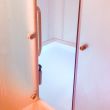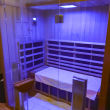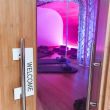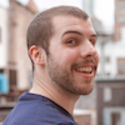Have you noticed lately that expensive relaxation has become chic? I'm talking about the recent influx of different boutique spa experiences focused almost exclusively on doing nothing and feeling great—obscure healing exercises, tony meditation centers, technological advancements in stillness, all with Swarovski-diamond encrusted price tags. It's all part of the self-care Renaissance, maybe, or we're living in a post-recession world or something, I don't know. What I do know is, in 2017, the price to chill out can be an extremely high one.
The cost for me to relax is about $15—the collective MSRP of a bottle of Crosby red wine and Zootopia rented for 24 hours on Apple TV. It works just as well as anything. But I wonder aloud to myself, sometimes, wine glass in hand and vintage Mac laptop perched on my bed: "Is there a better way to relax than this?" After three weeks of falling asleep in various Manhattan-based massage beds, beanbags, and one pool, I'm delighted to say: There is! I'm a changed man. Can you tell by the tone in which I'm typing?
My experiences were recorded in a little Shinola journal I bought a week ago out of peer pressure. I loved this assignment for two reasons: one, it combined my loves of doing nothing and spending money at the same time, and two; it got me back into journaling! My life was improved before I even began.
Is relaxing in New York worth the extremely prohibitive cost? Let's find out:
Floatation Therapy
Imagine floating naked in a small pool—but you don't really know it's a pool, because the water is room temperature so you can barely feel it, and it's so dark that you can't distinguish the room from what you see when your eyes are closed. You don't even know you're in room—you could be in an ocean. Wait, where are you? How is it so quiet two blocks from Grand Central Station? Are you going to be here forever? Is it even possible to imagine being bathed in nothingness? Such is the somewhat horrifying, somewhat blissful sensation of flotation therapy.
For a little over a hundred bucks, you too can lay in the ether of Chill Space NYC for an hour. It is unlike anything I have ever done before, and the experience is almost indescribable, so I apologize for any blind spots in this review. By reducing all external stimuli, floatation therapy allows you to be seized by a meditative state. After a few initial wandering thoughts—mine were all dinner-related—you truly don't think about anything. Give yourself over to the float and allow yourself to truly, deeply, sincerely relax.
One hour, however, is far too long. Because when your mind comes back to the stratosphere, you realize your body is still in outer space. You wonder, having picked the last available appointment for flotation therapy, if the staff has forgotten about you and gone home—forever. You accept Chill Space NYC as your final resting place. Where else in New York can you come face to face with your mortality for a thrifty $100?
Infrared Sauna
There is a lot of thought surrounding the infrared sauna experience: infrared rays penetrate the skin, heating your body much more effectively than a steam sauna would, and the whole experience is thought to be purifying and detoxifying. It is also really boring if you don't have a waterproof book or a podcast to listen to, which I didn't. I lay in the fetal position for 40 minutes, unable to convert my anxiety into perspiration, but Claire and Emily loved it. Let them tell you about it!
Acupuncture
Never underestimate the tranquility of having 50-some needles placed tenderly into your flesh by an Eastern medicine practitioner. This was one of the best things I did, and maybe the only thing on this list I will continue to do on the regular. It all starts with a man named Paul Kempisty—I just call him Paul because I love him so much.
Paul practices accupuncture, aromatherapy, and reiki out of an extremely zen office above the Chipotle on Spring Street. Upon walking in, you are immediately greeted by an enormous water fixture. If that doesn't scream "tranquility" but also "$$$", I don't know what does. For introductory sessions, Paul starts with an interview that's akin to talk therapy. His voice, a hybrid accent between Polish and Australian that sounds like whipped cream, lulls you into sharing all of your physical and mental secrets. Then, he sticks some needles in you.
Acupuncture is based on manipulating and releasing the energy flow of the body—which, if you're skeptical, sounds a little crazy, until you try it. I'm somebody who suffers from pretty moderate anxiety (I'm a writer! It's endearing!), which manifests itself both physically and mentally, and acupuncture treats it both ways. This looks like: several pins in the foot, which send signals to the brain to please relax and a few on my chest to stop overthinking this one meaningless encounter, while others placed around my body direct the flow of energy to restore balance. If your body is a temple, you've got to get spiritual. Acupuncture works. I bid adieu to Paul's water fixture feeling 10x more rejuvenated than after any massage. I miss him (his voice) tenderly, but I'm absolutely going back.
Sound Bathing
At the apex of yoga and meditation, there is sound bathing—available almost everywhere incense is sold. Basically, you do some quick and easy movements, and then a professional gives you a pillow and blanket and tucks you in for some ambient chiming. (The sound in which you are bathing.) The idea is to be present, so if you fall asleep, somebody will come up and gently tousle you awake. I thought it was a fine way to spend an hour, but I also think a nap at home is a fine way to spend an hour. I went with Emily Ferber and tried to reach her for comment:

Boutique Meditation
Meditation, a heightened state of being, can be hard to get to–just like it can be hard to fall asleep—but everyone theoretically can do it. It should be impossible to be bad at meditation, but trust me: I am really, really bad at meditation.
Inscape in Flatiron, a meditation center with a .life URL, does its best to accommodate people like me by doing absolutely everything short of sedation to ensure a relaxing experience. The music in the gift shop is ambient and all-consuming. The Dome, where my class was, is like a moistureless womb. They give you blankets, beanbags, and a voice recording of a friendly and beautiful-sounding Australian goddess to guide the process. I had every potential to relax, and I fucked it up wherever possible.
I sat on one of the custom meditation beanbags at the start of Mindfulness 33 (the number is how many minutes long the class is) and tried to make myself comfortable. The waiflike fairy woman who checked me in came over to me and handed me two cylindrical cushions, in case I needed "extra support," but I didn't know what they were for and nobody else was using them! As a result, my technique could be best described as "criss-cross applesauce; freeform." My legs were vaguely tangled before me, as if to say to the room, "We're relaxed! We're loose! Can't you tell? Everything is fine!!!!"
After 60 seconds of total womblike silence, the recording started, and I jumped an inch from my beanbag it was so startling. I spent the rest of my 33 minutes trying to follow descriptions of arm movements that included placing my elbows in front of me "like the bow of a ship" and timing my breathing to an unnatural pace. Every three minutes, my beanbag would slip one centimeter forward, bracing itself under my emotional weight. The silence portion was my favorite part—focusing on breathing, with a voiceover occasionally (abruptly, terrifyingly) asking us to drop our worries like a light rain into the lake of our awareness. Watch them ripple across your consciousness, and try to keep your beanbag still as possible.
"Us" refers to: two young heterosexual couples, a mother daughter duo having the time of their lives, a woman who's definitely done this before, and a handsome mysterious drifter named Brennan Kilbane. Mostly everyone seemed to enjoy themselves—I did not talk to them afterwards, but everybody spoke in hushed, enlightened tones. Probably all good meditators.
—Brennan Kilbane
Photographed by the author.








